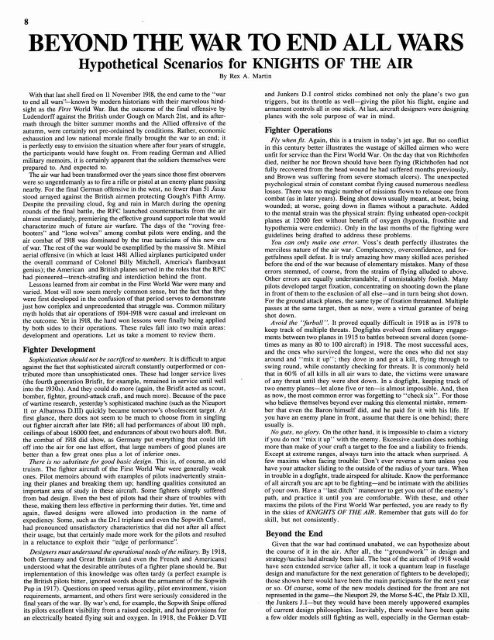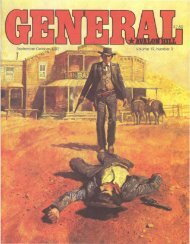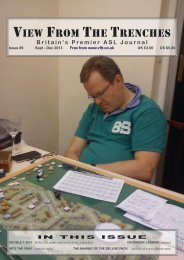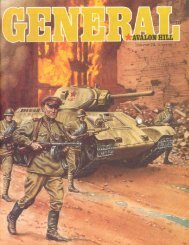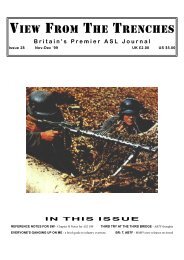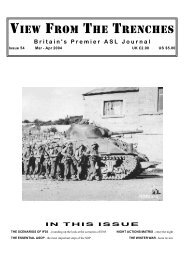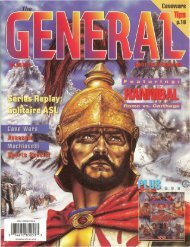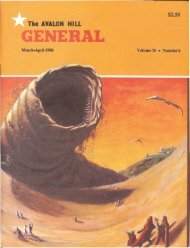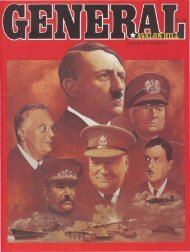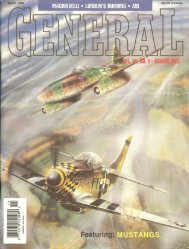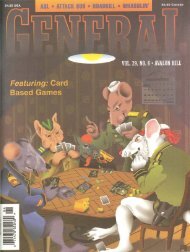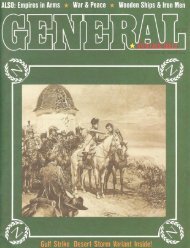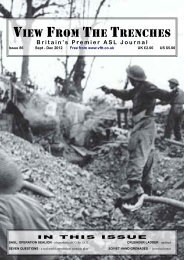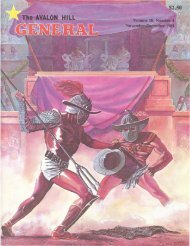18.64MB - View From The Trenches
18.64MB - View From The Trenches
18.64MB - View From The Trenches
- TAGS
- trenches
- www.vftt.co.uk
You also want an ePaper? Increase the reach of your titles
YUMPU automatically turns print PDFs into web optimized ePapers that Google loves.
BEYOND THE WAR TO END ALL WARS<br />
Hypothetical Scenarios for KNIGHTS OF THE AIR<br />
- -<br />
By Rex A. Martin<br />
With that last shell fired on 11 November 1918, the end came to the "war<br />
to end all wars'lknown by modern historians with their marvelous hind-<br />
sight as the First World War. But the outcome of the final offensive by<br />
Ludendorff against the British under Gough on March 21st, and its after-<br />
math through the bitter summer months and the Allied offensive of the<br />
autumn, were certainly not pre-ordained by conditions. Rather, economic<br />
exhaustion and low national morale finally brought the war to an end; it<br />
is perfectly easy to envision the situation where after four years of struggle,<br />
the participants would have fought on. <strong>From</strong> reading German and Allied<br />
military memoirs, it is certainly apparent that the soldiers themselves were<br />
prepared to. And expected to.<br />
<strong>The</strong> air war had been transformed over the years since those first observers<br />
were so ungentlemanly as to fire a rifle or pistol at an enemy plane passing<br />
nearby. For the final German offensive in the west, no fewer than 51 Jasta<br />
stood arrayed against the British airmen protecting Cough's Fifth Army.<br />
Despite the prevailing cloud, fog and rain in March during the opening<br />
rounds of the final battle, the RFC launched counterattacks from the air<br />
almost immediately, premiering the effective ground support role that would<br />
characterize much of future air warfare. <strong>The</strong> days of the "roving free-<br />
booters" and "lone wolves" among combat pilots were ending, and the<br />
air combat of 1918 was dominated by the true tacticians of this new era<br />
of war. <strong>The</strong> rest of the war would be exemplified by the massive St. Mihiel<br />
aerial offensive (in which at least 1481 Allied airplanes participated under<br />
the overall command of Colonel Billy Mitchell, America's flamboyant<br />
genius); the American and British planes served in the roles that the RFC<br />
had pioneered-trench-strafing and interdiction behind the front.<br />
Lessons learned from air combat in the First World War were many and<br />
varied. Most will now seem merely common sense, but the fact that they<br />
were first developed in the confusion of that period serves to demonstrate<br />
just how complex and unprecedented that struggle was. Common military<br />
myth holds that air operations of 1914-1918 were casual and irrelevant on<br />
the outcome. Yet in 1918, the hard won lessons were finally being applied<br />
by both sides to their operations. <strong>The</strong>se rules fall into two main areas:<br />
development and operations. Let us take a moment to review them.<br />
Fighter Development<br />
Sophistication should not be sacri$ced to numbers. It is difficult to argue<br />
against the fact that sophisticated aircraft constantly outperformed or con-<br />
tributed more than unsophisticated ones. <strong>The</strong>se had longer service lives<br />
(the fourth generation Brisfit, for example, remained in service until well<br />
into the 1930s). And they could do more (again, the Brisfit acted as scout,<br />
bomber, fighter, ground-attack craft, and much more). Because of the pace<br />
of wartime research, yesterday's sophisticated machine (such as the Nieuport<br />
11 or Albatross D.111) quickly became tomorrow's obsolescent target. At<br />
first glance, there does not seem to be much to choose from in singling<br />
out fighter aircraft after late 1916; all had performances of about 110 mph,<br />
ceilings of about 16000 feet, and endurances of about two hours aloft. But,<br />
the combat of 1918 did show, as Germany put everything that could lift<br />
off into the air for one last effort, that large numbers of good planes are<br />
better than a few great ones plus a lot of inferior ones.<br />
<strong>The</strong>re is no substitute for good basic design. This is, of course, an old<br />
truism. <strong>The</strong> fighter aircraft of the First World War were generally weak<br />
ones. Pilot memoirs abound with examples of pilots inadvertently strain-<br />
ing their planes and breaking them up; handling qualities consituted an<br />
important area of study in these aircraft. Some fighters simply suffered<br />
from bad design. Even the best of pilots had their share of troubles with<br />
these, making them less effective in performing their duties. Yet, time and<br />
again, flawed designs were allowed into production in the name of<br />
expediency. Some, such as the Dr.1 triplane and even the Sopwith Camel,<br />
had pronounced unsatisfactory characteristics that did not after all affect<br />
their usage, but that certainly made more work for the pilots and resulted<br />
in a reluctance to exploit their "edge of performance".<br />
Designers must understand the operational needs of the military. By 191 8,<br />
both Germany and Great Britain (and even the French and Americans)<br />
understood what the desirable attributes of a fighter plane should be. But<br />
implementation of this knowledge was often tardy (a perfect example is<br />
the British oilots bitter. , ignored ., words about the armament of the Souwith<br />
Pup in 1917). Questions on speed versus agility, pilot environment, vision<br />
requirements, armament, and others first were seriously considered in the<br />
fink years of the war. By war's end, for example, the sopwith Snipe offered<br />
its pilots excellent visibility from a raised cockpit, and had provisions for<br />
an electrically heated flying suit and oxygen. In 1918, the Fokker D.VII<br />
and Junkers D.1 control sticks combined not only the plane's two gun<br />
triggers, but its throttle as well-giving the pilot his flight, engine and<br />
armament controls all in one stick. At last, aircraft designers were designing<br />
planes with the sole purpose of war in mind.<br />
Fighter Operations<br />
Fly when fit. Again, this is a truism in today's jet age. But no conflict<br />
in this century better illustrates the wastage of skilled airmen who were<br />
unfit for service than the First World War. On the day that von Richthofen<br />
died, neither he nor Brown should have been flying (Richthofen had not<br />
fully recovered from the head wound he had suffered months previously,<br />
and Brown was suffering from severe stomach ulcers). <strong>The</strong> unexpected<br />
psychological strain of constant combat flying caused numerous needless<br />
losses. <strong>The</strong>re was no magic number of missions flown to release one from<br />
combat (as in later years). Being shot down usually meant, at best, being<br />
wounded; at worse, going down in flames without a parachute. Added<br />
to the mental strain was the physical strain: flying unheated open-cockpit<br />
planes at 12000 feet without benefit of oxygen (hypoxia, frostbite and<br />
hypothemia were endemic). Only in the last months of the fighting were<br />
guidelines being drafted to address these problems.<br />
You can only make one error. Voss's death perfectly illustrates the<br />
merciless nature of the air war. Complacency, overconfidence, and for-<br />
getfulness spell defeat. It is truly amazing how many skilled aces perished<br />
before the end of the war because of elementary mistakes. Many of these<br />
errors stemmed, of course, from the strains of flying alluded to above.<br />
Other errors are equally understandable, if unmistakably foolish. Many<br />
pilots developed target fixation, concentrating on shooting down the plane<br />
in front of them to the exclusion of all else-and in turn being shot down.<br />
For the ground attack planes, the same type of fixation threatened. Multiple<br />
passes at the same target, then as now, were a virtual gurantee of being<br />
shot down.<br />
Avoid the "ji4rball". It proved equally difficult in 1918 as in 1978 to<br />
keep track of multiple threats. Dogfights evolved from solitary engage-<br />
ments between two planes in 1915 to battles between several dozen (some-<br />
times as many as 80 to 100 aircraft) in 1918. <strong>The</strong> most successful aces,<br />
and the ones who survived the longest, were the ones who did not stay<br />
around and "mix it up"; they dove in and got a kill, flying through to<br />
swing round, while constantly checking for threats. It is commonly held<br />
that in 60% of all kills in all air wars to date, the victims were unaware<br />
of any threat until they were shot down. In a dogfight, keeping track of<br />
two enemy planes-let alone five or ten-is almost impossible. And, then<br />
as now, the most common error was forgetting to "check six". For those<br />
who believe themselves beyond ever making this elemental mistake, remem-<br />
ber that even the Baronihimself did, and he paid for it with his life. If<br />
you have an enemy plane in front, assume that there is one behind; there<br />
usually is.<br />
No guts, no glory. On the other hand, it is impossible to claim a victory<br />
if you do not "mix it up" with the enemy. Excessive caution does nothing<br />
more than make of your craft a target to the foe and a liability to friends.<br />
Except at extreme ranges, always turn into the attack when surprised. A<br />
few maxims when facing trouble: Don't ever reverse a turn unless you<br />
have your attacker sliding to the outside of the radius of your turn. When<br />
in trouble in a dogfight, trade airspeed for altitude. Know the performance<br />
of all aircraft you are apt to be fighting-and be intimate with the abilities<br />
of your own. Have a "last ditch" maneuver to get you out of the enemy's<br />
path, and practice it until you are comfortable. With these, and other<br />
maxims the pilots of the First World War perfected, you are ready to fly<br />
in the skies of KNIGHTS OF THE AIR. Remember that guts will do for<br />
skill, but not consistently.<br />
Beyond the End<br />
Given that the war had continued unabated, we can hypothesize about<br />
the course of it in the air. After all, the "groundwork" in design and<br />
strategyltactics had already been laid. <strong>The</strong> best of the aircraft of 1918 would<br />
have seen extended service (after all, it took a quantum leap in fuselage<br />
design and manufacture for the next generation of fighters to be developed);<br />
those shown here would have been the main participants for the next year<br />
or so. Of course, some of the new models destined for the front are not<br />
represented in the game-the Nieuport 29, the Morse S4C, the Pfalz D.XII,<br />
the Junkers J.1-but they would have been merely uppowered examples<br />
of current design philosophies. Inevitably, there would have been quite<br />
a few older models still fighting as well, especially in the German estab-


